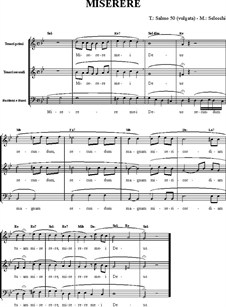The Miserere
 The Good Friday processions are accompanied by an ancient penitential prayer, the Miserere, sung in Latin, an hymn to the merciful God raised by the repentant sinner who asks for forgiveness. This psalm, which is one of the seven penitential psalms of the liturgy (indicated by Number 50 according to the Vulgate and by Number 51 according to Jewish tradition) expresses the perfect size of the moral weakness of the human being. The opening words of the psalm are “Miserere mei Deus” (Have mercy on me, God). It was written and prayed by King David around 970 BC. In it, David, after meeting with the prophet Nathan, who reproached him the double sin of adultery with Bathsheba and the killing of her husband, Uriah, invokes the mercy of God and praises him, sure, in faith, of His forgiveness. Year by year, during the period of Lent, the traditional appointment with the “Chorus of the Miserere” is repeated.
The Good Friday processions are accompanied by an ancient penitential prayer, the Miserere, sung in Latin, an hymn to the merciful God raised by the repentant sinner who asks for forgiveness. This psalm, which is one of the seven penitential psalms of the liturgy (indicated by Number 50 according to the Vulgate and by Number 51 according to Jewish tradition) expresses the perfect size of the moral weakness of the human being. The opening words of the psalm are “Miserere mei Deus” (Have mercy on me, God). It was written and prayed by King David around 970 BC. In it, David, after meeting with the prophet Nathan, who reproached him the double sin of adultery with Bathsheba and the killing of her husband, Uriah, invokes the mercy of God and praises him, sure, in faith, of His forgiveness. Year by year, during the period of Lent, the traditional appointment with the “Chorus of the Miserere” is repeated.
The singing of the Miserere is the backdrop to numerous celebrations of the Easter period, in particular is often sung during processions that take place on Good Friday. One of the most notable examples is the ancient Good Friday Procession of Chieti. The choir of the archconfraternity of the Sacred Mountain of the Dead sings the version of the song set to music by the composer from Chieti Saverio Selecchy. In Sessa Aurunca (Caserta) and Latera (Viterbo), the rite of the Week, orally handed down generation by generation, provides the singing of the Miserere. Even in Gubbio (Perugia), from the Middle Ages, the “Procession of the Dead Christ” takes place in the streets of the city, evoking the symbols of the Passion. The singers, divided into two choirs of Christ and the Virgin Mary, accompany the two wooden statues with the singing of the verses of Psalm 50.
In Naples, the tradition of the Miserere is very ancient, as shown by the 5 voices composition of Cristoforo Caresana (Venice 1640 – Naples 1709) in 1687, preserved in the musical archive of the Girolamini. Other authors wrote music for the Miserere for the Easter celebrations that were performed at the Oratorio filippino or other religious institutions of the city of Naples, in particular thanks to the presence of many brotherhoods. Among the famous composers who were active between the seventeenth and eighteenth centuries are: Gaetano Veneziano, Francesco Feo, Leonardo Leo, Davide Perez, Nicola Conti and so on. The tradition of processions reminiscent of the Passion of Christ was widespread throughout Italy in the baroque period and a particular attention to such practices occurred in Campania. Even today there are very suggestive celebrations, such as the Choir of the Colleggiata di Somma Vesuviana (Naples), or the singers of Miserere in Sessa Aurunca.
